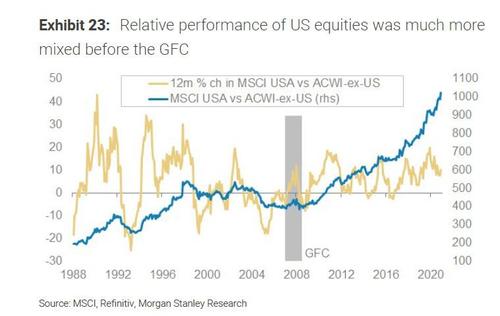Morgan Stanley: Here’s Why We See No Rate Hikes In 2022 And What That Means For Markets
By Vishwanath Tirupattur, global head of Quantitative Research at Morgan Stanley
This has been our outlook week. We published our year-ahead global economics and strategy outlooks last Sunday, and more detailed asset class and country-specific outlooks have been streaming out during the week. At Morgan Stanley Research, our outlooks are the culmination of weeks of deliberation and spirited debate among economists and strategists across all the regions and asset classes we cover. In our highly inter-related world, where everything effectively affects everything else, I am convinced that such a collaborative exercise is necessary. In last week’s Start, my colleague Andrew Sheets summarized the outcome of the process – our outlook for 2022 across markets and economies. This week, I will focus on the key debates we engaged in during the process.
Our economists’ view that the Fed will wait until 1Q23 to make its first interest rate hike, despite their projection that US unemployment will fall to 3.6% by end-2022, was hotly debated. Considering that the current market pricing implies about two full hikes next year, we focused on two key questions:
-
why does the Fed wait, and
-
when does the market reflect that delay?
For interest rates and FX markets, this was the crux of the matter, especially in the context of potential changes to the composition of the FOMC. Our economists see two drivers for no hikes in 2022 – falling core PCE inflation and rising labor force participation. The market could see more support for these expectations as soon as March and no later than June next year. Furthermore, they do not see material changes to policy outcomes as a consequence of potential changes in the composition of the FOMC. This is key to our narrative on interest rates and FX: markets first price in a more hawkish Fed outcome (bear-flattening, higher real yields, strong DXY) before shifting to concern that the Fed may be too dovish (bear-steepening, higher breakevens, weaker DXY).
The forecasts our strategists presented were more cautious than our economists’ expectations of strong growth, moderating inflation, and patient central banks, leading us to debate whether this is a set-up for ‘Goldilocks’. Didn’t our economic forecasts imply the best of all possible worlds and, as such, a better environment for markets? As it turned out, in some instances (Europe and Japan equities, for example), this is what our strategists forecast. But across several other markets – US equities, US and European corporate credit, agency mortgages, to name a few – our strategists saw more challenges, especially early in the year.
Central banks may ultimately prove dovish, but that may not be immediately apparent, an uncertain dynamic that could push yields and USD higher. US earnings are already elevated relative to the economy and face a potential tax headwind. In credit, current valuations leave little margin for error, and even modest or idiosyncratic stresses can weigh on returns. Agency mortgages have to contend with the two largest buyers, the Fed and banks, slowing their purchases next year, while other investors will need to digest about US$200 billion more mortgages in 2022 than in 2021.
We also debated whether we should be more constructive on emerging markets. The case seemed reasonable: EM assets underperformed materially in 2021. With better valuations, better growth, and no Fed hike until 2023, shouldn’t we join the chorus calling for improvement? The debate around this point was robust, but we settled on ‘not yet’. We think that the market will be slow to price in our ‘later-than-expected’ Fed lift-off, leading to initial USD strength. The one exception is China high yield credit, where we think that the market is underestimating the resolve and ability of policy-makers to control disruption in the property sector, leading our credit strategists to turn bullish on China high yield.
Another topic of debate was the divergence between US and European equity markets. In their base cases, our equity strategists forecast a 5% decline in the S&P 500 versus an 8% rise in MSCI Europe. After all, for more than a decade, US stocks have outperformed European equities meaningfully.
Part of the rationale is idiosyncratic: US equities face a potential tax headwind to earnings and a much larger rise in real rates than other developed market regions. Those factors alone could equate to a double-digit adjustment, before considering valuation differences. Our equity strategists expect to see the best earnings growth next year across different regions in Europe and greater uncertainty about earnings in the US. Furthermore, thanks to lower inflationary pressures, the ECB can afford to be more patient than the Fed. Even though US equity underperformance has been rare since the global financial crisis (GFC), it is worth noting that such occurrences were less uncommon before the GFC.
Enjoy your Sunday.
Tyler Durden
Sun, 11/21/2021 – 15:30
via ZeroHedge News https://ift.tt/32mx3s1 Tyler Durden
